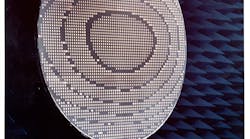A broadband, circularly polarized reflectarray (RA) has been developed for Ka-band radar and satellite-communications (satcom) applications. The printed-circuit reflectarray, which measures 25 × 25 RA with physical size of 90 × 90 mm2, consists of two dielectric substrate layers attached by adhesive. The lower substrate is Duroid 5880 circuit material with dielectric constant (Dk) of 2.2, and the upper is Duroid 6010 circuit material with Dk of 10.2, both from Rogers Corp. An international team of researchers from Egypt, France, China, and the University of Mississippi, Oxford, coordinated their efforts on the compact array’s development by creating a unit cell and then optimizing it for best radiation pattern performance throughout the array.
The RA and its unit cell were simulated with the aid of the Microwave Studio computer-aided-engineering (CAE) software from Computer Simulation Technology (CST). It predicted the effects of signal-incidence angle on the RA’s performance as well as the effects of air holes and metallic plated viaholes on the multiple-circuit-board RA structure.
The software was also used to design a dual-mode, circularly polarized feed horn for the RA. The dual-mode feed horn uses separate coaxial connectors for left-handed circular polarization (LHCP) and right-handed circular polarization (RHCP). The RA was designed as a broadside radiator with a design frequency of 30 GHz. Simulations of radiation patterns agreed closely with measurements at microwave and millimeter-wave frequencies (from 27 to 35 GHz) made on commercial test equipment.
See “Ka-Band Circularly Polarized Reflectarray,” IEEE Antennas & Propagation Magazine, Vol. 58, No. 4, August, 2016, p. 60.

